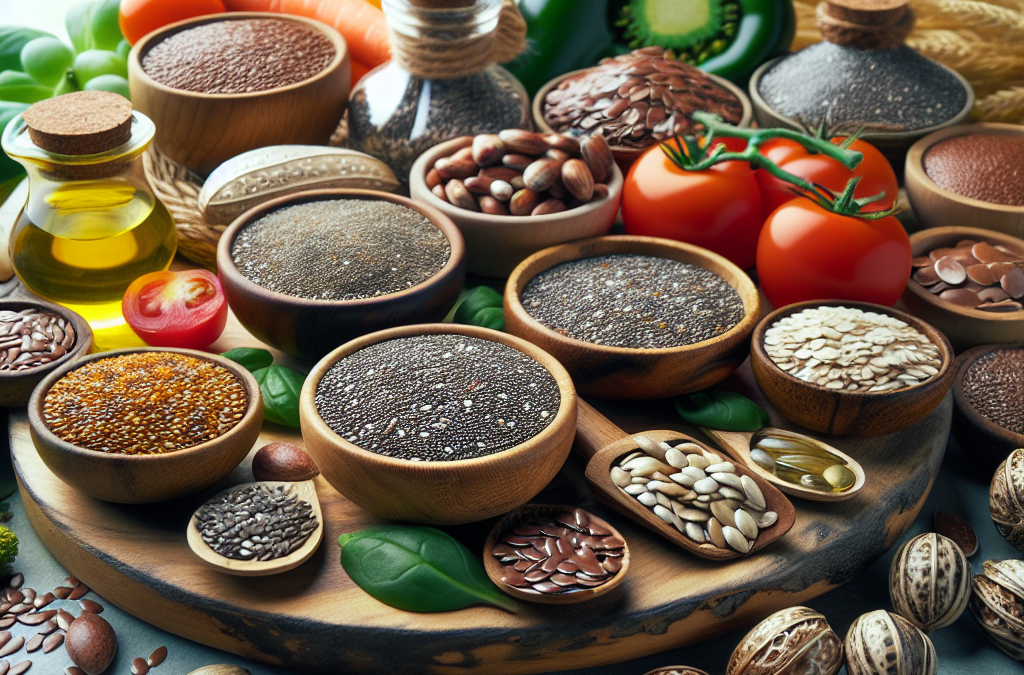Understanding Omega-3 Fatty Acids
What Are Omega-3s?
When I first started exploring the world of nutrition, I quickly learned that omega-3 fatty acids are a big deal. These are essential fats that our bodies can’t produce on their own, so we need to get them from our diet. There are three main types: ALA, EPA, and DHA. ALA (alpha-linolenic acid) is primarily found in plant sources while EPA and DHA are mainly in fish and algae. It’s crazy how something so small can be so important, right?
I remember being confused about why everyone was so obsessed with these tiny fatty acids. But it turns out, they play crucial roles in brain function, heart health, and even reducing inflammation. After diving into research, I realized that these benefits are exactly what many people look for in their diets.
So, if you’re trying to up your omega-3 game, knowing the difference between these types is key. Especially if you’re leaning towards a plant-based diet, understanding ALA is where you’ll want to focus your efforts.
Why Omega-3s Matter
As I started making changes to my diet, I was surprised to learn just how many functions omega-3s support. They’re not just another health fad; they can really affect how you feel day to day. This includes mood stability and cognitive function, something I genuinely experienced during my personal health journey.
Don’t overlook heart health either; dietary omega-3s can significantly lower levels of triglycerides and reduce the risk of heart disease. So, these little fats can pack a big punch when it comes to overall health. It’s like having a secret weapon in your wellness toolbox!
When I incorporated more omega-3s into my diet, I noticed improvements in my energy levels and mental clarity. It’s kind of magical how these nutrients can boost your day-to-day vibe! Just be sure to balance your intake to reap the most benefits.
Sources of Plant-Based Omega-3s
Alright, let’s talk about how to get ALA into your life if you’re into plant-based living. There are tons of options! Seeds, nuts, and oils are your go-to sources. Ground flaxseeds are packed with omega-3 and are super easy to add to smoothies or oatmeal.
Chia seeds are another fantastic option. I love tossing them into my yogurt or making chia pudding for breakfast. You can also try walnuts, which not only give you that omega-3 goodness but also add a satisfying crunch to salads and snacks!
And don’t forget about hemp seeds! They offer a nutty flavor and are great sprinkled on just about anything. All these options made it so much easier for me to get my daily omega-3s without relying on fish oil, which was a game changer for my plant-based journey.
Debunking Common Myths About Plant-Based Omega-3s
Myth: Plant-Based Omega-3s Aren’t as Effective
One of the biggest myths I encountered was that plant-based omega-3s aren’t effective. Many people believe that ALA can’t be converted into EPA and DHA, which are typically found in fish. However, research shows that our bodies can convert a portion of ALA into these beneficial forms! That was a revelation for me.
It’s worth noting that the conversion efficiency can vary from person to person, influenced by factors like diet and overall health. But don’t let that stop you from loading up on ALA-rich foods! Every small amount contributes to your overall health.
During my research, I also found that those who consume a balanced, plant-based diet often do just fine in maintaining healthy omega-3 levels. So, don’t sweat it if fish isn’t your thing—there are plenty of delicious alternatives out there!
Myth: You Can’t Get Enough Omega-3s on a Plant-Based Diet
Many folks are surprised when I tell them that it is entirely possible to meet your omega-3 needs on a plant-based diet. One thing I learned in my transition to plant-based eating is that variety is crucial. It’s all about getting creative with your meals and incorporating a range of omega-3 sources!
At first, I thought I would struggle to find enough variety, but I soon discovered that my local grocery store had a wealth of options. From chia puddings to flaxseed muffins, I was able to satisfy my cravings while getting those precious omega-3s.
And let me tell you, once I began tracking my intake, I realized that with good planning, it was easy to hit my omega-3 targets without feeling deprived. You could even consider making your own smoothies and energy bars at home to enjoy healthy snacks regularly!
Myth: Only Supplements Can Provide Omega-3s
Another common misconception is that to get sufficient omega-3s, you must resort to supplements. This couldn’t be further from the truth! Sure, supplements like algae oil can be great for some, but whole foods are always my preference. They provide a full spectrum of nutrients that supplements often lack.
Plus, eating food is way more enjoyable! I remember how much better I felt knowing I was nourishing my body with real ingredients as opposed to popping pills every day. The taste and the textures of whole foods can enhance your meals significantly.
So, if you’re looking to up your omega-3 game, I encourage you to explore the whole food sources. It’s all about creating delicious dishes while enjoying the benefits that nature provides!
Get an Amazing Discount on the Best Certified Organic Whole Food Supplement!
Incorporating More Omega-3s into Your Diet
Simple Swaps for Omega-3-Rich Foods
After learning about different sources of omega-3s, I realized making swaps was an easy way to boost my intake. For instance, swapping regular salad dressing with flaxseed oil or hemp seed oil not only added flavor but also packed in more omega-3s.
Another swap I love is using ground chia seeds instead of eggs in baking. This not only caters to my plant-based lifestyle but adds those healthy fats too! It’s like hitting two birds with one stone!
By merely letting the little changes accumulate, I saw visible improvements in both my overall health and how my body felt day to day. It’s an effortless way to integrate nutrition into our daily lives.
Creating Balanced Meals
Creating meals that are balanced and rich in omega-3s was a fun challenge for me. Every week, I made it a point to include at least one source of ALA in my meals. Bowls loaded with quinoa, greens, and topped with walnuts or seeds became my go-to!
It’s also crucial to consider the combination of foods consumed. Pairing omega-3-rich foods with other nutrients can enhance absorption. That’s why I often include a sprinkle of lemon juice with my chia seed pudding or flaxseed in my smoothies. Little details make a big difference!
Don’t be afraid to experiment! For instance, I enjoy adding hemp seeds to my salads, or even slipping some into my hummus for added creaminess. Cooking can be creative, and it’s all about finding what makes you feel good.
Maintaining Consistency
Once I established a routine around incorporating omega-3-rich foods, consistency became key. I started to look forward to these nutritious additions! Whether it was my Sunday meal prep or nighttime snack, it became second nature to reach for those healthy sources.
One hack I found helpful was keeping a stash of omega-3-rich snacks and meals in my fridge. This way, whenever I craved something delicious, I knew I was also nourishing my body. It worked wonders during my busy weeks.
It’s all about making omega-3s a part of your lifestyle instead of a chore. Once you find what works for you, you might be surprised at how easy it is to maintain a healthy, omega-3-rich diet!
Conclusion
As I navigated through the world of plant-based omega-3s, I learned so much about their importance and the misconceptions around them. The more I educated myself, the more empowered I felt to take control of my health. Whether through delicious recipes or small dietary tweaks, incorporating omega-3s doesn’t have to be complicated or difficult.
So, to anyone out there unsure about how to get started or feeling overwhelmed—we’re all on this journey together. Your journey can be as fun or as simple as you want it to be! Just remember to be mindful, experiment, and enjoy the process.
Trust me, once you see the benefits of these powerful fatty acids, you’ll understand why they truly deserve a place in your diet.
FAQs
1. What are omega-3 fatty acids?
Omega-3 fatty acids are essential fats that are vital for various bodily functions, including brain health and reducing inflammation. They can be found in both plant and animal sources.
2. Can I get enough omega-3s on a plant-based diet?
Absolutely! You can obtain sufficient omega-3s through plant sources like flaxseeds, chia seeds, walnuts, and hemp seeds. Variety is key!
3. Are supplements necessary for omega-3 intake?
Supplements aren’t necessary if you can meet your omega-3 needs through whole foods. Whole foods have added nutrients and flavors that supplements don’t offer.
4. How can I incorporate more omega-3s into my meals?
You can make simple swaps, such as using nut oils, adding seeds to your dishes, and creating balanced meals focused on omega-3 sources. Meal prepping can also help!
5. Are there any myths about plant-based omega-3s?
Some myths include the idea that plant-based omega-3s aren’t effective or that you can’t get enough from a plant-based diet. In truth, with proper planning, you can meet all your omega-3 needs with plant foods!




